Mineralogy, Geochemistry and Tectonic Setting of the Raobazhai Ultramafic Complex, North Dabie
Abstract
:1. Introduction
2. Geological Setting and Sample Descriptions
3. Analytical Methods
3.1. Whole-Rock Major Element
3.2. Mineral Major Element
3.3. Whole-Rock Trace Element
3.4. HSE and Re–Os Isotope Analyses
4. Results
4.1. Mineral Major Element Compositions
4.1.1. Olivine
4.1.2. Spinel and Chromite
4.2. Whole-Rock Major Element Compositions
4.3. Whole-Rock Trace Element Compositions
4.4. HSE and Re-Os Isotopic Compositions
5. Discussion
5.1. Partial Melting and Melt/Fluid Metasomatism
5.2. Effect of Melt/Fluid Metasomatism on HSE
5.2.1. PGE and Re
5.2.2. Re-Os Isotope System
5.3. Tectonic Setting
6. Conclusions
- (1)
- Our geochemical study of Raobazhai spinel harzburgites and chromite harzburgites showed that the former had experienced 6–17% partial melting and the latter partial melting degree experienced higher. Some samples are rich in Na and enriched in elements such as Sr, Ba, and U and while depleted in Nb, Zr, and Hf. This indicates that the Raobazhai harzburgites experienced low to moderate partial melting and then boninitic melt/fluid metasomatism. The normalized PGE pattern of the mantle showed that most spinel harzburgites had a flat pattern. In contrast, the chromite harzburgites and some spinel harzburgites had a right-dipping PPGE pattern, indicating that the PPGE was carried out of the complex by the melt under a high degree of partial melting. Detailed analysis showed that Re/Ir was significantly lower than that of the partial melting model, indicating that the partial melting process can effectively remove incompatible Re, and that the Raobazhai harzburgites had also experienced Pd-rich Cu-Ni sulfide melt metasomatism. Combined with previous studies and ductile deformation in petrography, it was considered that the Raobazhai harzburgites are OCCs with oceanic affinity. The enrichment in Na, Sr, Ba, and U and the negative anomaly of trace elements Nb, Zr, and Hf suggest that Pt–Pd differentiation in chromite harzburgites may be influenced by the fore-arc process.
- (2)
- We propose three possible explanations for the above characteristics: (a) the abyssal type mantle peridotites were metasomatized during subduction by plate fluids and glassy magma; (b) before the ocean-continent collision, IAB metasomatism occurred in the mantle peridotite located in the accretionary wedge; (c) the CMCC in the fore-arc was metasomatic using IAB.
Supplementary Materials
Author Contributions
Funding
Data Availability Statement
Acknowledgments
Conflicts of Interest
References
- Carlson, R.W.; Pearson, D.G.; James, D.E. Physical, chemical, and chronological characteristics of continental mantle. Rev. Geophys. 2005, 43, 1–24. [Google Scholar] [CrossRef]
- Griffin, W.L.; O’Reilly, S.Y.; Afonso, J.; Begg, G. The Composition and Evolution of Lithospheric Mantle: A Re-evaluation and its Tectonic Implications. J. Pet. 2008, 50, 1185–1204. [Google Scholar] [CrossRef] [Green Version]
- Sleep, N.H. Evolution of the Continental Lithosphere. Annu. Rev. Earth Planet. Sci. 2005, 33, 369–393. [Google Scholar] [CrossRef] [Green Version]
- Bodinier, J.L.; Vasseur, G.; Vernieres, J.; Dupuy, C.; Fabries, J. Mechanisms of Mantle Metasomatism: Geochemical Evidence from the Lherz Orogenic Peridotite. J. Pet. 1990, 31, 597–628. [Google Scholar] [CrossRef]
- Lenardic, A.; Moresi, L.; Mühlhaus, H. Longevity and stability of cratonic lithosphere: Insights from numerical simulations of coupled mantle convection and continental tectonics. J. Geophys. Res. Earth Surf. 2003, 108, 2303–2330. [Google Scholar] [CrossRef] [Green Version]
- Zhao, D. Global tomographic images of mantle plumes and subducting slabs: Insight into deep Earth dynamics. Phys. Earth Planet. Inter. 2004, 146, 3–34. [Google Scholar] [CrossRef]
- Jin, Y.B.; Zhi, X.C.; Meng, Q.; Gao, T.S.; Peng, Z.C. Re-Os dating of the Raobazhai ultramafic massif in North Dabie. Chin. Sci. Bull. 2004, 49, 508–513. (In Chinese) [Google Scholar] [CrossRef]
- Wang, X.B.; Yang, J.S.; Chen, S.Y.; Shi, R.D. Origin and structural nature of Raobozhai ultramafic rock: A discussion. Acta Petrol. Sin. 2005, 21, 1593–1608. (In Chinese) [Google Scholar]
- Wu, Y.B.; Chen, D.G.; Cheng, H.; Xia, Q.K. Geochemicalcharacteristics of retrometamorphic eclogite in Raobazai, northern Dabie Mountains. Seis. Geol. 2000, 22, 99–103. (In Chinese) [Google Scholar]
- Zhang, Q.; Ma, B.L.; Liu, R.X.; Zhao, D.S.; Fan, Q.C.; Li, Q.; Li, X.Y. A remnant of continental lithospheric mantle above sub-duction zone: Geochemical constraints on ultramafic rock from Raobazhai area, Anhui Province. Sci. China Ser. B Chem. Life Sci. Earth Sci. 1995, 38, 1522–1529. (In Chinese) [Google Scholar]
- You, Z.D. Eclogite inclusions found in spinel peridotite on the northern slope of Dabie Mountains, Anhui. Earth Sci. Front. 2000, 1, 588. (In Chinese) [Google Scholar]
- Zhi, X.C.; Jin, Y.B.; Meng, Q.; Gao, T.S. Trace element geochemistry of Raobazhai utramafic complex Noth Dabie Mountain. Acta Petrol. Sin. 2004, 20, 463–472. (In Chinese) [Google Scholar]
- Wang, X.B. Answers to the comments on the article “Origin and structural nature of Raobozhai ultramafic rock: A discussion”. Acta Petrol. Sin. 2006, 22, 3084–3089. (In Chinese) [Google Scholar]
- Yang, X.Y. A ultramalic cold intrusion in the dabie area recognitions on the Raobazhai rock body. Bulletin of the Nanjing Institute of Greology. Chin. Acad. Geol. Sci. 1983, 4, 81–99. (In Chinese) [Google Scholar]
- Zheng, J.; Sun, M.; Griffin, W.; Zhou, M.; Zhao, G.; Robinson, P.; Tang, H.; Zhang, Z. Age and geochemistry of contrasting peridotite types in the Dabie UHP belt, eastern China: Petrogenetic and geodynamic implications. Chem. Geol. 2008, 247, 282–304. [Google Scholar] [CrossRef]
- Zheng, L.; Zhi, X.; Reisberg, L. Re–Os systematics of the Raobazhai peridotite massifs from the Dabie orogenic zone, eastern China. Chem. Geol. 2009, 268, 1–14. [Google Scholar] [CrossRef]
- Sun, H.; Xiao, Y.L.; Gu, H.O.; Wang, Y.Y.; Wang, X.X. Complicated evolutions of eclogite from Raobazhai, North Dabie, central-eastern China. Acta Petrol. Sin. 2018, 34, 3497–3508. (In Chinese) [Google Scholar]
- Yan, F.C.; Liu, Q.; Ma, X.Y.; He, M. Metamorphic P-T-t path and tectonic implication of garnet pyroxenite from Raobazhai, North Dabie Complex, central-eastern China. Acta Petrol. Sin. 2021, 37, 2579–2598. (In Chinese) [Google Scholar]
- Chu, Z.-Y.; Wu, F.-Y.; Walker, R.; Rudnick, R.; Pitcher, L.; Puchtel, I.S.; Yang, Y.-H.; Wilde, S. Temporal Evolution of the Lithospheric Mantle beneath the Eastern North China Craton. J. Pet. 2009, 50, 1857–1898. [Google Scholar] [CrossRef] [Green Version]
- Birck, J.L.; Barman, M.R.; Capmas, F. Re-Os Isotopic Measurements at the Femtomole Level in Natural Samples. Geostand. Geoanal. Res. 1997, 21, 19–27. [Google Scholar] [CrossRef]
- Walker, R.; McDonough, W.; Honesto, J.; Chabot, N.; McCoy, T.J.; Ash, R.D.; Bellucci, J.J. Modeling fractional crystallization of group IVB iron meteorites. Geochim. Cosmochim. Acta 2008, 72, 2198–2216. [Google Scholar] [CrossRef]
- Saha, A.; Basu, A.; Jacobsen, S.; Poreda, R.; Yin, Q.-Z.; Yogodzinski, G. Slab devolatilization and Os and Pb mobility in the mantle wedge of the Kamchatka arc. Earth Planet. Sci. Lett. 2005, 236, 182–194. [Google Scholar] [CrossRef]
- Meisel, T.; Moser, J. Reference materials for geochemical PGE analysis: New analytical data for Ru, Rh, Pd, Os, Ir, Pt and Re by isotope dilution ICP-MS in 11 geological reference materials. Chem. Geol. 2004, 208, 319–338. [Google Scholar] [CrossRef]
- Warren, J.M. Global variations in abyssal peridotite compositions. Lithos 2016, 248–251, 193–219. [Google Scholar] [CrossRef]
- Parkinson, I.J.; Pearce, J.A. Peridotites from the Izu-Bonin-Mariana Forearc (ODP Leg 125): Evidence for Mantle Melting and Melt-Mantle Interaction in a Supra-Subduction Zone Setting. J. Pet. 1998, 39, 1577–1618. [Google Scholar] [CrossRef]
- Pearce, J.A.; Barker, P.F.; Edwards, S.J.; Parkinson, I.J.; Leat, P.T. Geochemistry and tectonic significance of peridotites from the South Sandwich arc-basin system, South Atlantic. Contrib. Miner. Pet. 2000, 139, 36–53. [Google Scholar] [CrossRef]
- Niu, Y. Mantle Melting and Melt Extraction Processes beneath Ocean Ridges: Evidence from Abyssal Peridotites. J. Pet. 1997, 38, 1047–1074. [Google Scholar] [CrossRef]
- Day, J.; Walker, R.; Warren, J.M. 186Os–187Os and highly siderophile element abundance systematics of the mantle revealed by abyssal peridotites and Os-rich alloys. Geochim. Cosmochim. Acta 2017, 200, 232–254. [Google Scholar] [CrossRef] [Green Version]
- Niu, Y. Bulk-rock Major and Trace Element Compositions of Abyssal Peridotites: Implications for Mantle Melting, Melt Extraction and Post-melting Processes Beneath Mid-Ocean Ridges. J. Pet. 2004, 45, 2423–2458. [Google Scholar] [CrossRef] [Green Version]
- Niu, Y.; Hékinian, R. Basaltic liquids and harzburgitic residues in the Garrett Transform: A case study at fast-spreading ridges. Earth Planet. Sci. Lett. 1997, 146, 243–258. [Google Scholar] [CrossRef] [Green Version]
- Becker, H.; Horan, M.; Walker, R.; Gao, S.; Lorand, J.-P.; Rudnick, R. Highly siderophile element composition of the Earth’s primitive upper mantle: Constraints from new data on peridotite massifs and xenoliths. Geochim. Cosmochim. Acta 2006, 70, 4528–4550. [Google Scholar] [CrossRef]
- Barnes, S.; Mungall, J.E.; Maier, W.D. Platinum group elements in mantle melts and mantle samples. Lithos 2015, 232, 395–417. [Google Scholar] [CrossRef]
- Meisel, T.; Walker, R.; Irving, A.J.; Lorand, J.-P. Osmium isotopic compositions of mantle xenoliths: A global perspective. Geochim. Cosmochim. Acta 2001, 65, 1311–1323. [Google Scholar] [CrossRef]
- Hellebrand, E.; Snow, J.E.; Dick, H.J.B.; Hofmann, A.W. Coupled major and trace elements as indicators of the extent of melting in mid-ocean-ridge peridotites. Nature 2001, 410, 677–681. [Google Scholar] [CrossRef]
- Liu, T.; Wu, F.-Y.; Liu, C.-Z.; Zhu, D.-C.; Lin, Y.-Z. Recycling of ancient sub-oceanic mantle in the Neo-Tethyan asthenosphere: Evidence from major and trace elements and Hf–Os isotopes of the Kop Mountain ophiolite, NE Turkey. Geochim. et Cosmochim. Acta 2021, 311, 43–58. [Google Scholar] [CrossRef]
- Tsai, C.-H.; Liou, J.G. Eclogite-facies relics and inferred ultrahigh-pressure metamorphism in the North Dabie Complex, central-eastern China. Am. Miner. 2000, 85, 1–8. [Google Scholar] [CrossRef]
- Chen, Y.; Su, B.; Guo, S. The Dabie-Sulu orogenic peridotites: Progress and key issues. Sci. China Earth Sci. 2015, 58, 1679–1699. [Google Scholar] [CrossRef]
- Piccardo, G.; Zanetti, A.; Müntener, O. Melt/peridotite interaction in the Southern Lanzo peridotite: Field, textural and geochemical evidence. Lithos 2007, 94, 181–209. [Google Scholar] [CrossRef]
- Johnson, K.T.M.; Dick, H.J.B.; Shimizu, N. Melting in the oceanic upper mantle: An ion microprobe study of diopsides in abyssal peridotites. J. Geophys. Res. Earth Surf. 1990, 95, 2661–2678. [Google Scholar] [CrossRef] [Green Version]
- Keays, R. The role of komatiitic and picritic magmatism and S-saturation in the formation of ore deposits. Lithos 1995, 34, 1–18. [Google Scholar] [CrossRef]
- Liu, J.; Rudnick, R.; Walker, R.; Gao, S.; Wu, F.; Piccoli, P. Processes controlling highly siderophile element fractionations in xenolithic peridotites and their influence on Os isotopes. Earth Planet. Sci. Lett. 2010, 297, 287–297. [Google Scholar] [CrossRef]
- Pearson, D.; Irvine, G.; Ionov, D.; Boyd, F.; Dreibus, G. Re–Os isotope systematics and platinum group element fractionation during mantle melt extraction: A study of massif and xenolith peridotite suites. Chem. Geol. 2004, 208, 29–59. [Google Scholar] [CrossRef]
- Liu, T.; Wu, F.-Y.; Liu, C.-Z.; Zhang, C.; Ji, W.-B.; Xu, Y. Reconsideration of Neo-Tethys evolution constrained from the nature of the Dazhuqu ophiolitic mantle, southern Tibet. Contrib. Miner. Pet. 2019, 174, 1–23. [Google Scholar] [CrossRef]
- Xu, Y.; Liu, J.; Xiong, Q.; Su, B.-X.; Scott, J.M.; Xu, B.; Zhu, D.-C.; Pearson, D.G. The complex life cycle of oceanic lithosphere: A study of Yarlung-Zangbo ophiolitic peridotites, Tibet. Geochim. Cosmochim. Acta 2020, 277, 175–191. [Google Scholar] [CrossRef]
- Xu, Y.; Li, D.N.; Li, D.X.; Dong, G.C.; Pearson, D.G.; Liu, J.A. Modification of Lithospheric Mantle by Melts/Fluids with Dif-ferent Sulfur Fugacities During the Wilson Cycle: Insights from Lesvos and Global Ophiolitic Peridotites. J. Geophys. Res. Solid Earth 2021, 126, e2021JB022445. [Google Scholar] [CrossRef]
- Kepezhinskas, P.; Defant, M.J. Nonchondritic Pt/Pd ratios in arc mantle xenoliths: Evidence for platinum enrichment in depleted island-arc mantle sources. Geology 2001, 29, 851–854. [Google Scholar] [CrossRef]
- Peregoedova, A.; Barnes, S.-J.; Baker, D. The formation of Pt–Ir alloys and Cu–Pd-rich sulfide melts by partial desulfurization of Fe–Ni–Cu sulfides: Results of experiments and implications for natural systems. Chem. Geol. 2004, 208, 247–264. [Google Scholar] [CrossRef]
- Lorand, J.-P.; Luguet, A.; Alard, O. Platinum-group element systematics and petrogenetic processing of the continental upper mantle: A review. Lithos 2013, 164–167, 2–21. [Google Scholar] [CrossRef]
- Van Acken, D.; Becker, H.; Hammerschmidt, K.; Walker, R.J.; Wombacher, F. Highly siderophile elements and Sr–Nd isotopes in refertilized mantle peridotites—A case study from the Totalp ultramafic body, Swiss Alps. Chem. Geol. 2010, 276, 257–268. [Google Scholar] [CrossRef]
- Horan, M.; Walker, R.; Morgan, J.; Grossman, J.; Rubin, A. Highly siderophile elements in chondrites. Chem. Geol. 2003, 196, 27–42. [Google Scholar] [CrossRef]
- Rudnick, R.L.; Walker, R. Interpreting ages from Re–Os isotopes in peridotites. Lithos 2009, 112, 1083–1095. [Google Scholar] [CrossRef]
- Alard, O.; Luguet, A.; Pearson, N.J.; Griffin, W.L.; Lorand, J.-P.; Gannoun, A.; Burton, K.W.; O’Reilly, S.Y. In situ Os isotopes in abyssal peridotites bridge the isotopic gap between MORBs and their source mantle. Nature 2005, 436, 1005–1008. [Google Scholar] [CrossRef] [PubMed]
- Harvey, J.; Day, J.M.D. Introduction to highly siderophile and strongly chalcophile elemnts in high temperature geochemis-try and cosmochemistry. Rev. Mineral. Geochem. 2016, 81, iii–xiv. [Google Scholar]
- Liu, C.-Z.; Xu, Y.; Wu, F.-Y. Limited recycling of crustal osmium in forearc mantle during slab dehydration. Geology 2018, 46, 239–242. [Google Scholar] [CrossRef]
- Liu, C.Z. Geochemical Characteristics and Significance of Oceanic Peridotite in the Arctic Gakkel Ultra-slowly Spreading Ridge. Ph.D. Thesis, Inslitute of Geology and Geophysics, Chinese Academy of Sciences, Beijing, China, 2007. [Google Scholar]
- Liu, C.-Z.; Snow, J.E.; Hellebrand, E.; Brügmann, G.; Von Der Handt, A.; Büchl, A.; Hofmann, A.W. Ancient, highly heterogeneous mantle beneath Gakkel ridge, Arctic Ocean. Nature 2008, 452, 311–316. [Google Scholar] [CrossRef] [PubMed]
- O’Reilly, S.Y.; Zhang, M.; Griffin, W.L.; Begg, G.; Hronsky, J. Ultradeep continental roots and their oceanic remnants: A solution to the geochemical “mantle reservoir” problem? Lithos 2009, 112, 1043–1054. [Google Scholar] [CrossRef]
- Urann, B.M.; Dick, H.J.B.; Parnell-Turner, R.; Casey, J.F. Recycled arc mantle recovered from the Mid-Atlantic Ridge. Nat. Commun. 2020, 11, 1–9. [Google Scholar] [CrossRef] [PubMed]
- Zhai, M.G.; Cong, B.L.; Zhao, Z.Y.; Wang, Q.C.; Wang, G.; Liang, L.L. Petrological-tectonic units in the coesite-bearing meta-morphic terrain of the Dabie Mountains, central China and their geotectonic implications. J. Southeast Asian. Earth. Sci. 1994, 11, 11–13. [Google Scholar]
- Xu, S.; Liu, Y.; Su, W.; Wang, R.; Jiang, L.; Wu, W. Discovery of the eclogite and its petrography in the Northern Dabie Mountain. Chin. Sci. Bull. 2000, 45, 273–278. [Google Scholar] [CrossRef]
- Xu, S.T.; Liu, Y.C.; Wu, W.P. The Ultramafic Rock Belt (UMRB) as a Metamorphosed Tectonic Mélange in Northern Dabie Mountains, eastern central China. In Paradoxes in Geology; Briegel, U., Xiao, W., Eds.; Elsevier Science B.V.: Amsterdam, The Netherlands, 2001; pp. 323–342. [Google Scholar] [CrossRef]
- Ballhaus, C.; Berry, R.; Green, D.H. Oxygen fugacity controls in the Earth’s upper mantle. Nature 1990, 348, 437–440. [Google Scholar] [CrossRef]
- Parkinson, I.J.; Arculus, R.J. The redox state of subduction zones: Insights from arc-peridotites. Chem. Geol. 1999, 160, 409–423. [Google Scholar] [CrossRef]
- Yu, Z.T.; Li, J.B.; Ding, W.W.; Zhang, J.; Liang, Y.Y.; Zhu, L. Research progress on oceanic core complexes and detachment faults. Adv. Mar. Sci. 2014, 32, 415–426. [Google Scholar]
- AO, S.J.; Xiao, W.J.; Yang, L.; Zhang, J.E.; Wan, B.; Zhang, Z.Y. The typical characteristics and tectonic implications of fossil Oceanic Core Complex (OCC) in orogenic belt. Sci. China Earth Sci. 2017, 47, 1–22. (In Chinese) [Google Scholar]
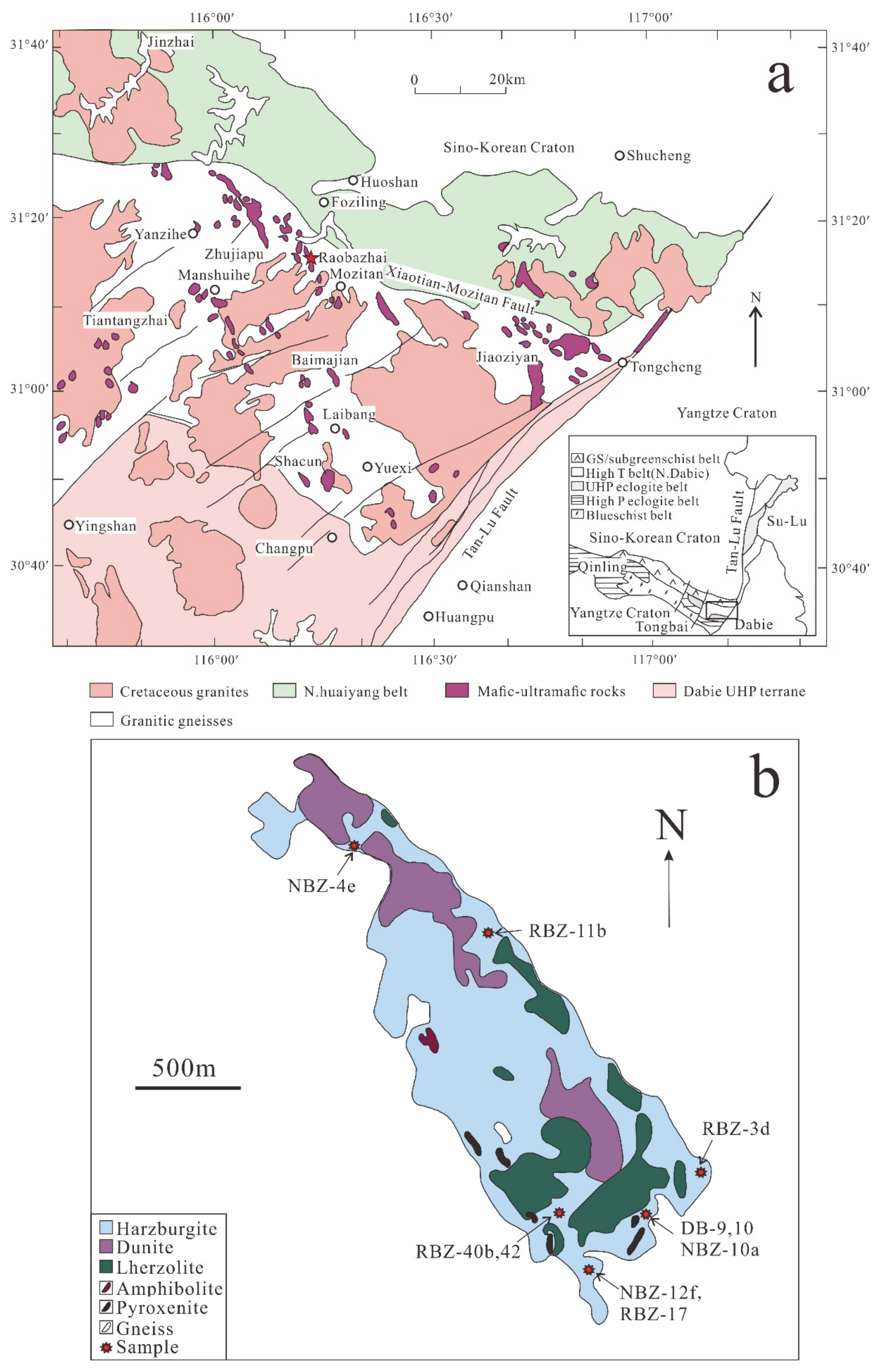
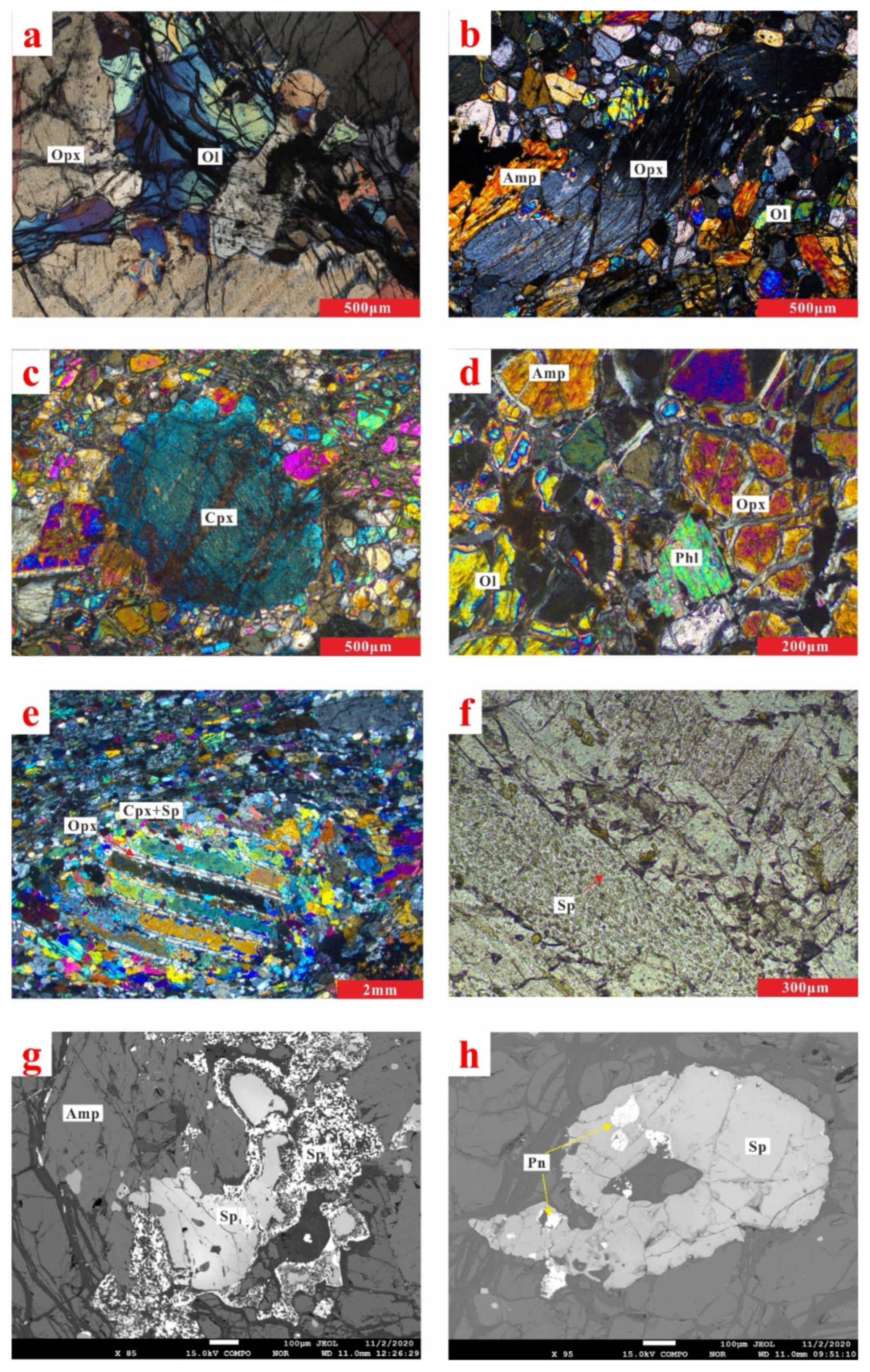
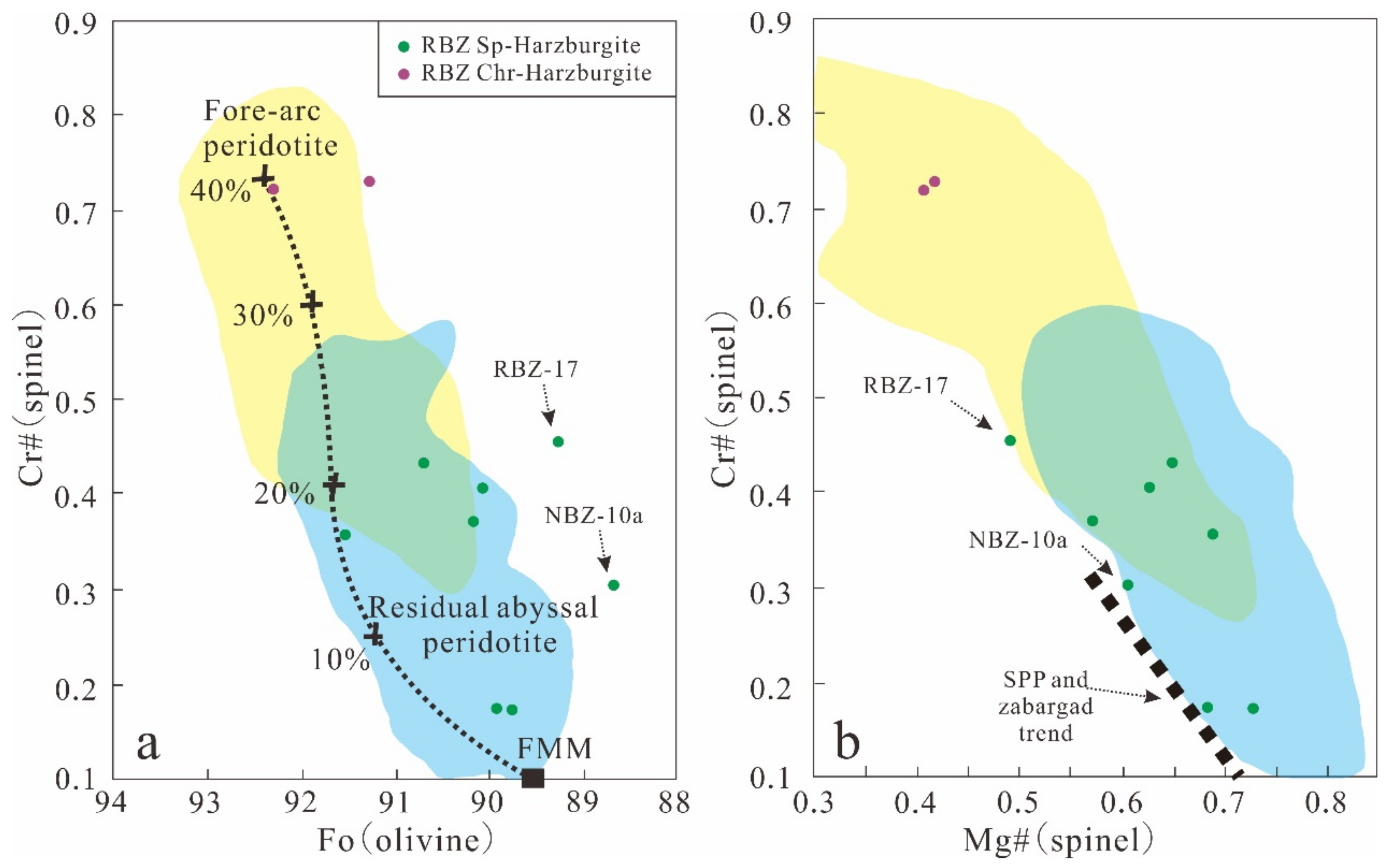


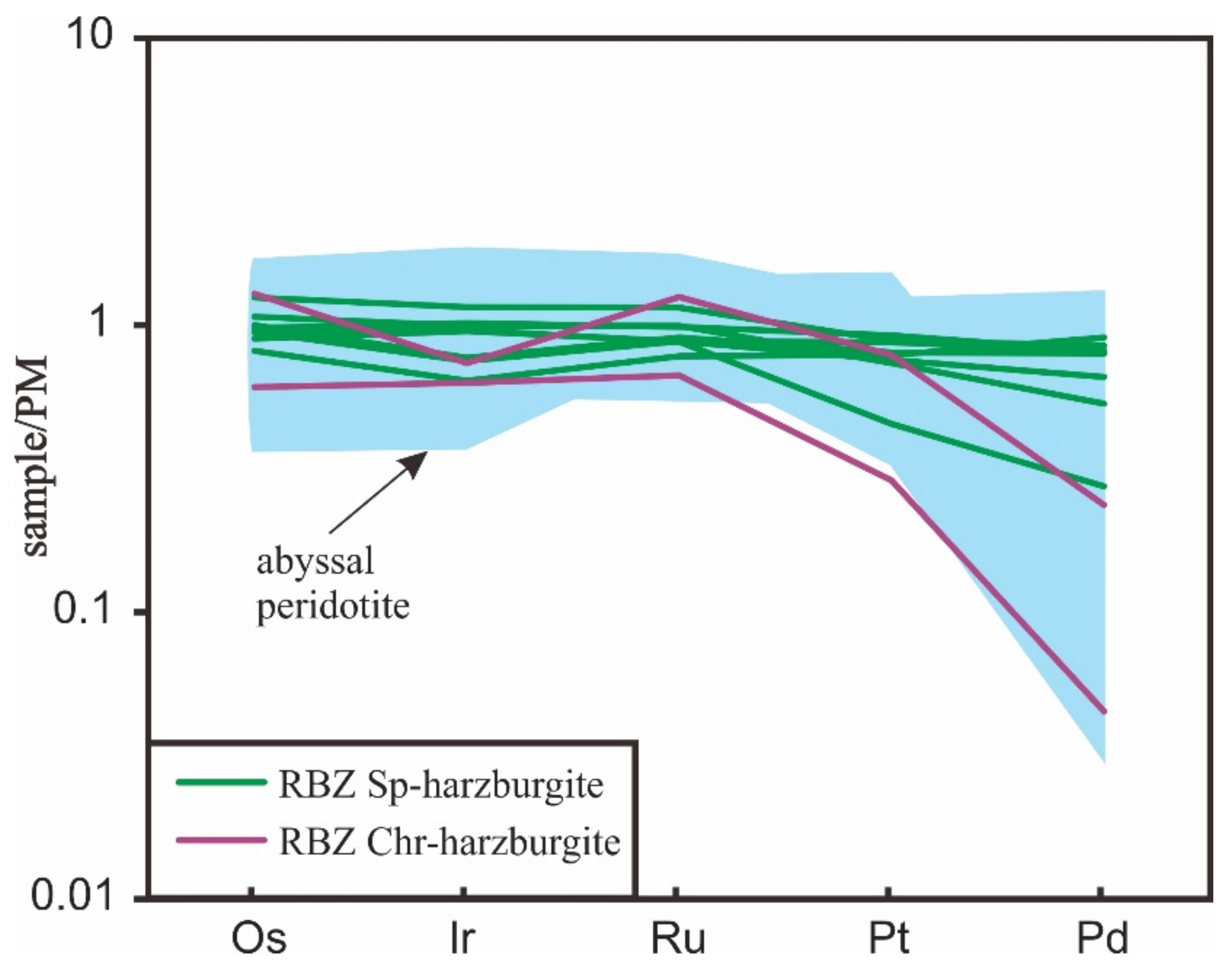
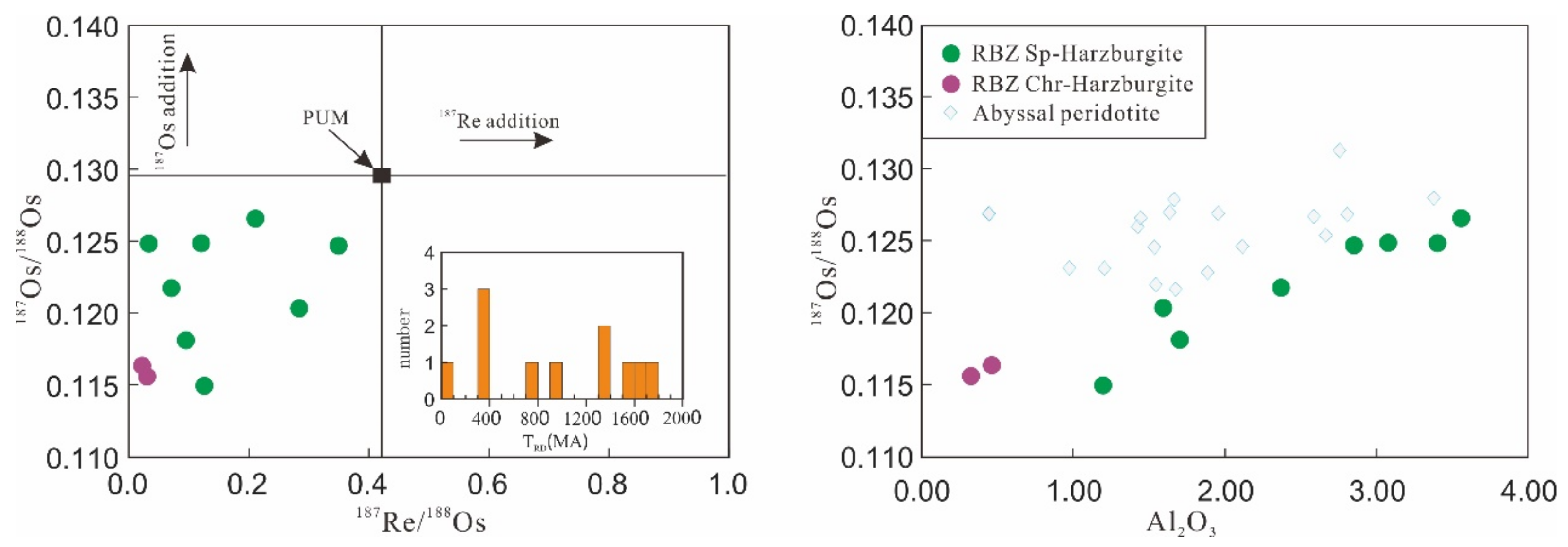
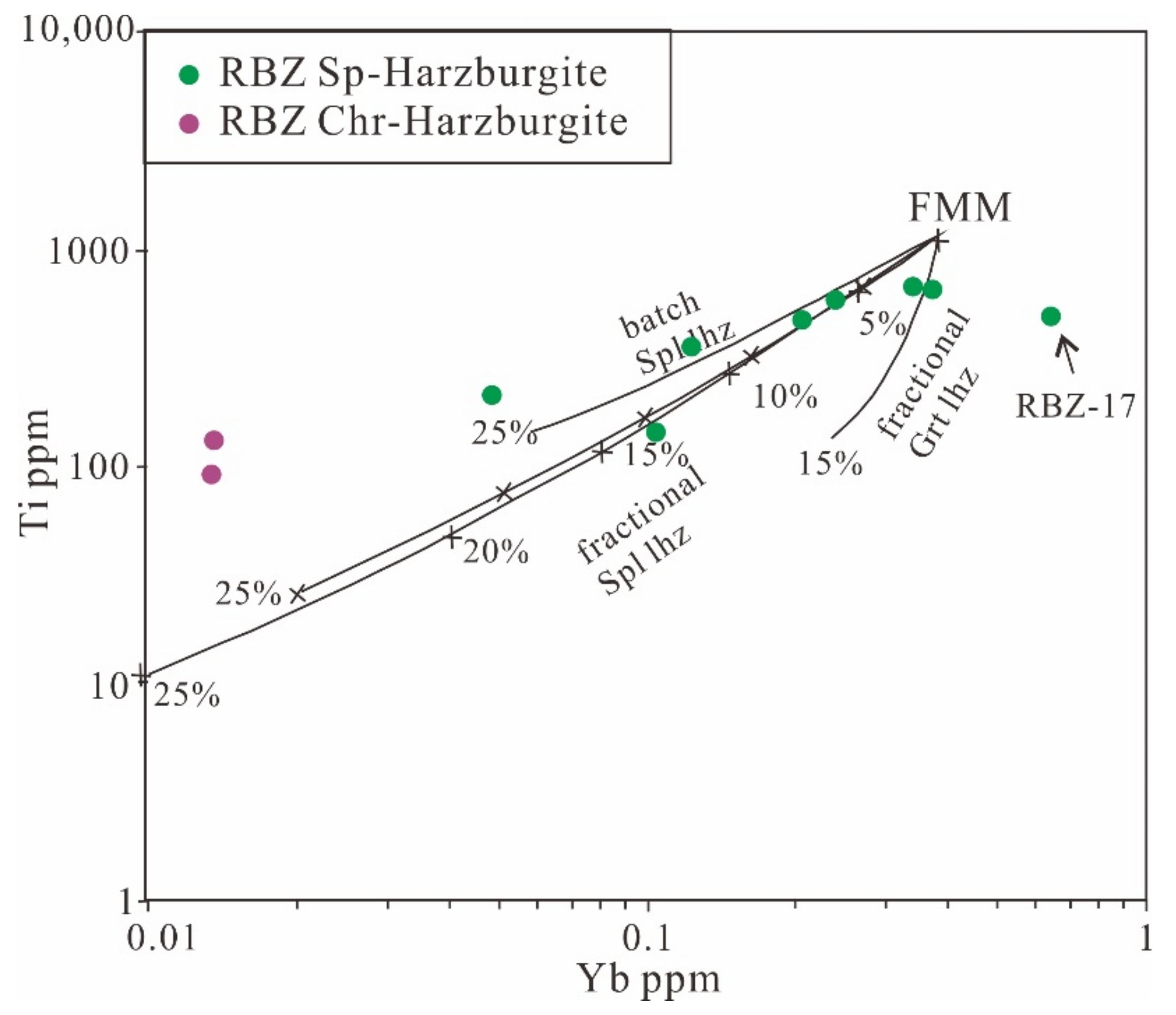
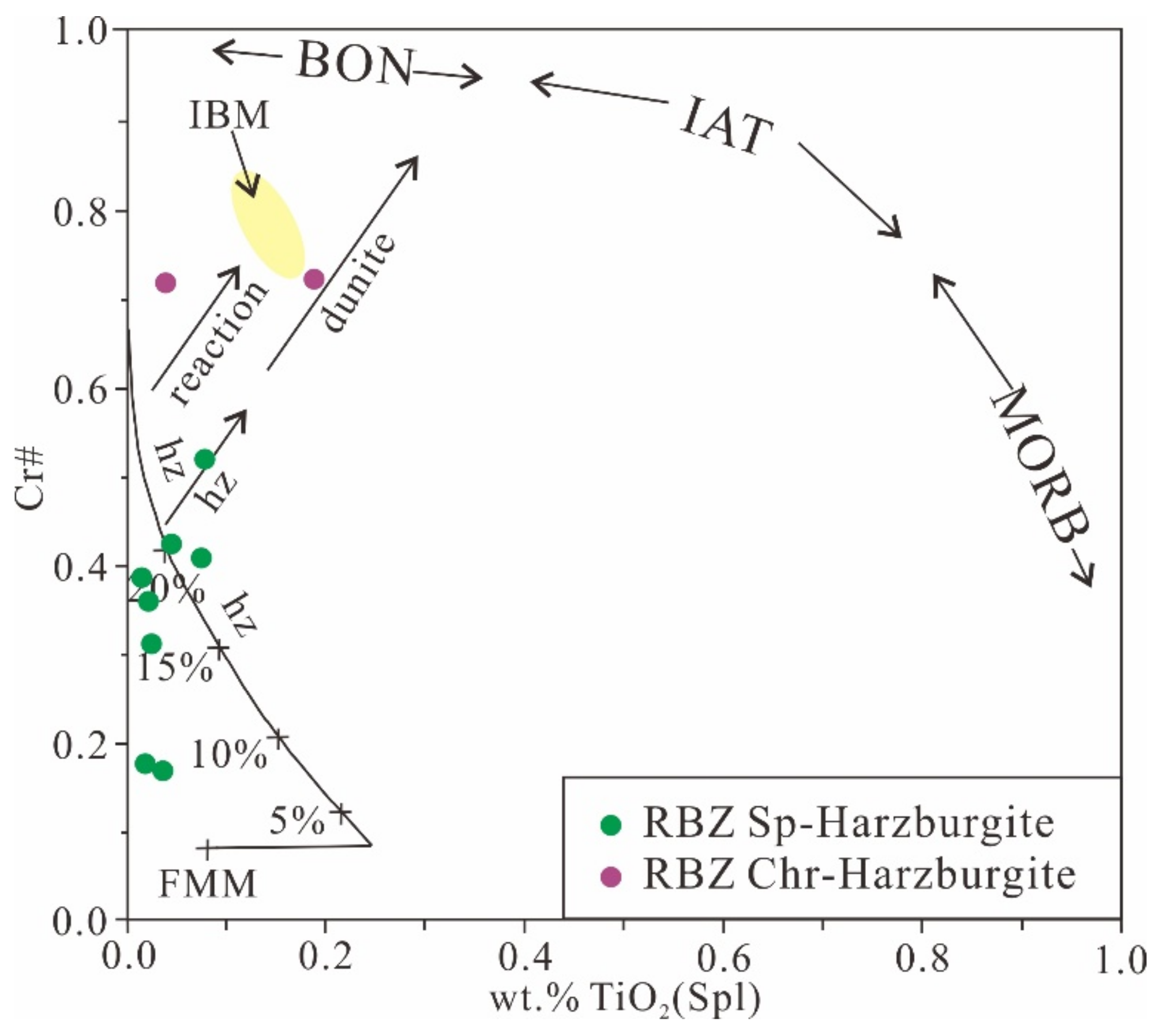
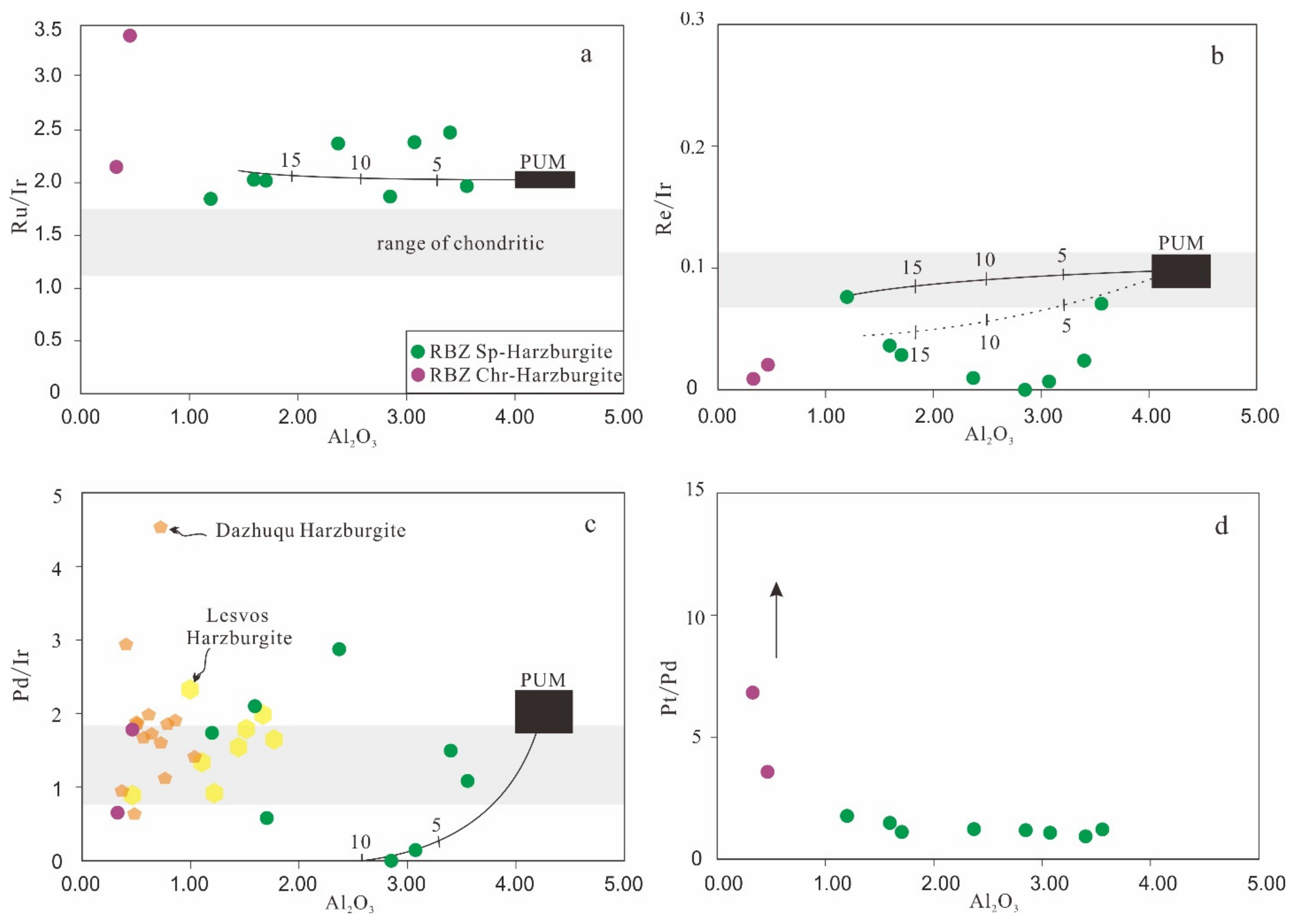
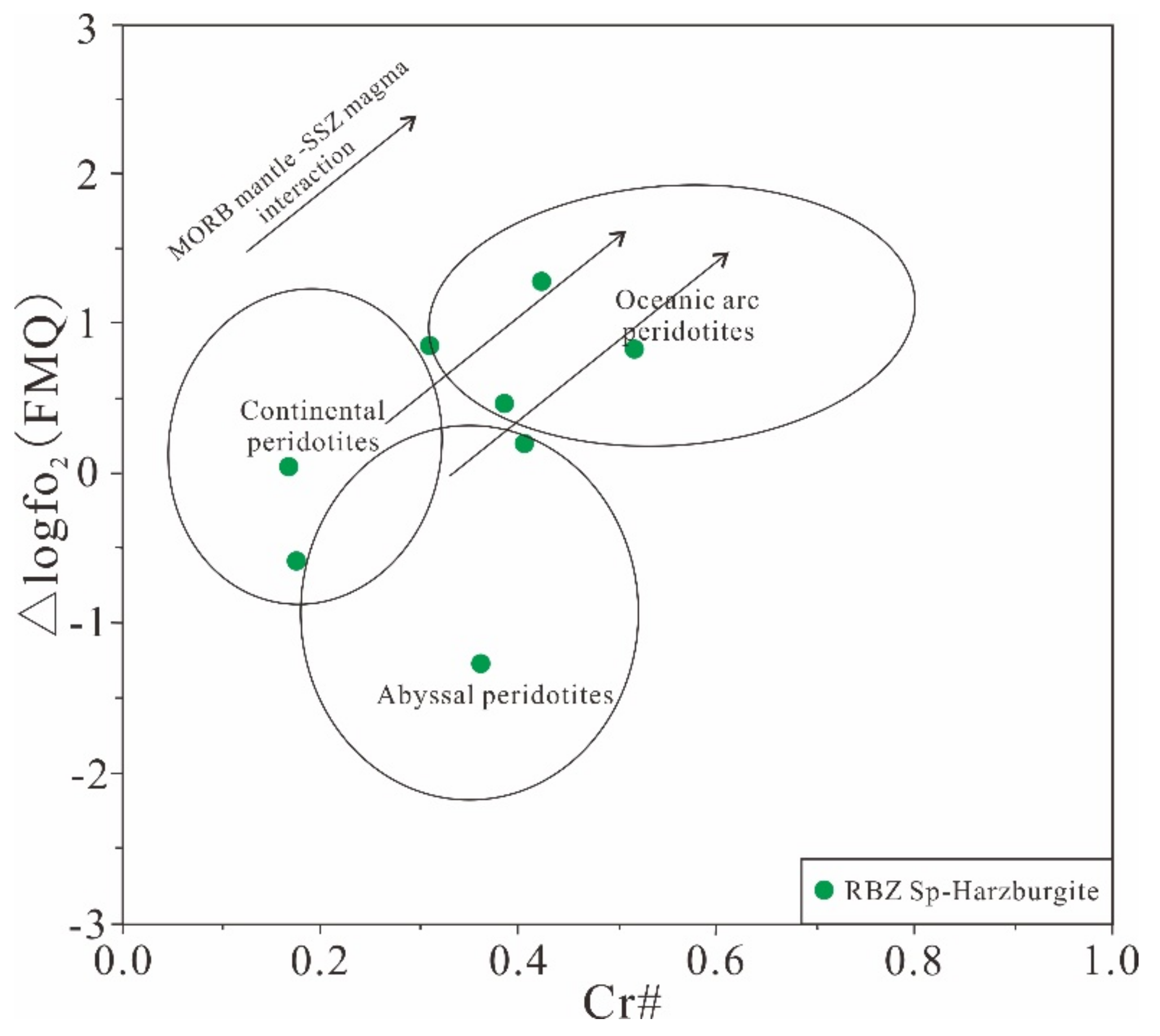
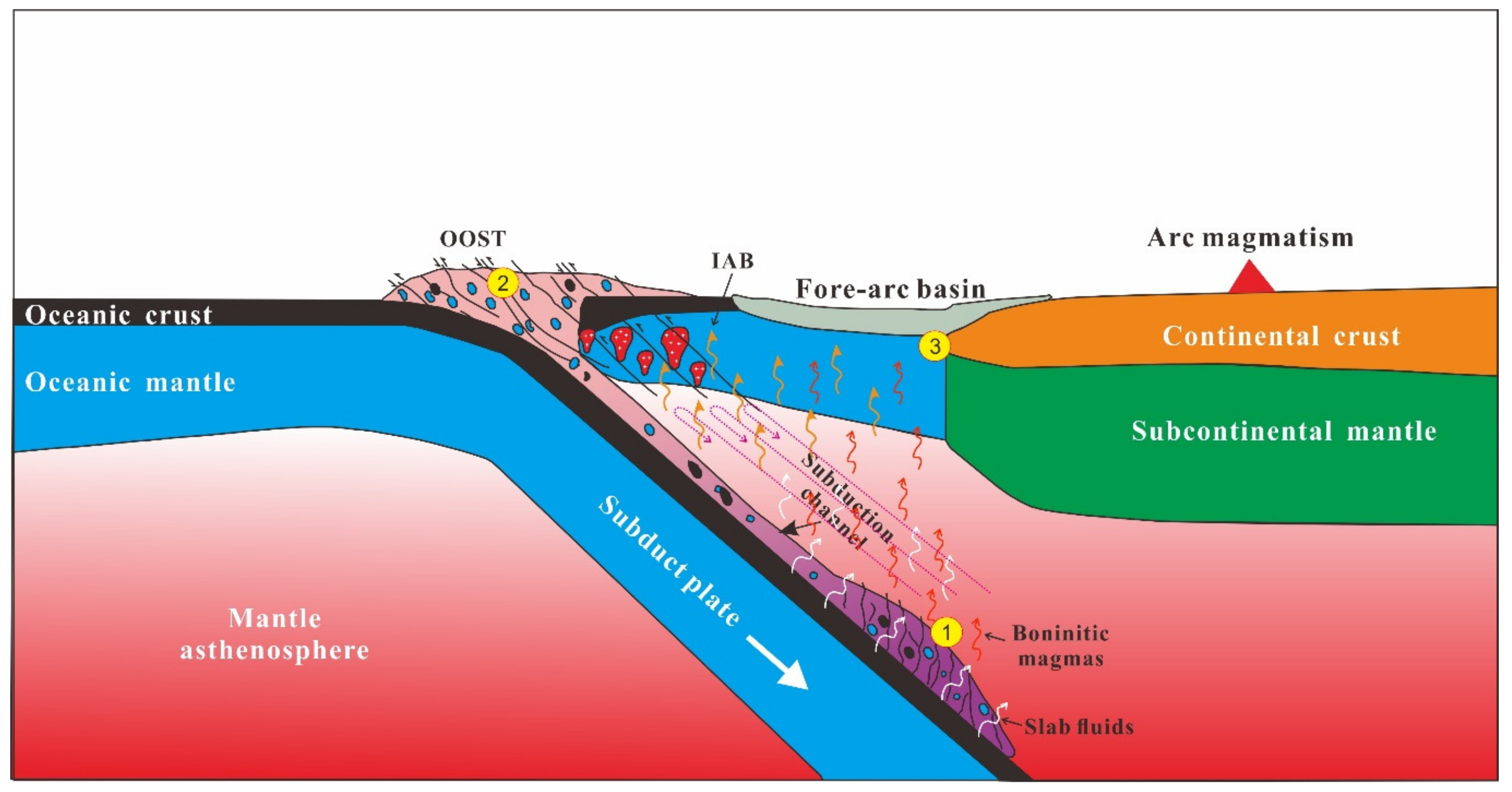
Publisher’s Note: MDPI stays neutral with regard to jurisdictional claims in published maps and institutional affiliations. |
© 2022 by the authors. Licensee MDPI, Basel, Switzerland. This article is an open access article distributed under the terms and conditions of the Creative Commons Attribution (CC BY) license (https://creativecommons.org/licenses/by/4.0/).
Share and Cite
Yan, F.; Liu, Q.; Hou, Q.; He, M. Mineralogy, Geochemistry and Tectonic Setting of the Raobazhai Ultramafic Complex, North Dabie. Minerals 2022, 12, 286. https://doi.org/10.3390/min12030286
Yan F, Liu Q, Hou Q, He M. Mineralogy, Geochemistry and Tectonic Setting of the Raobazhai Ultramafic Complex, North Dabie. Minerals. 2022; 12(3):286. https://doi.org/10.3390/min12030286
Chicago/Turabian StyleYan, Fangchao, Qing Liu, Quanlin Hou, and Miao He. 2022. "Mineralogy, Geochemistry and Tectonic Setting of the Raobazhai Ultramafic Complex, North Dabie" Minerals 12, no. 3: 286. https://doi.org/10.3390/min12030286




